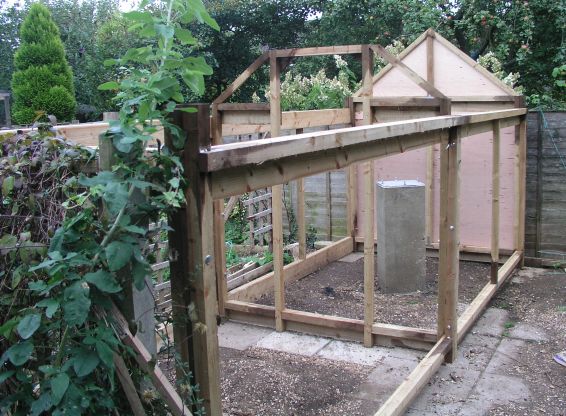

I have put the doorway in the nearer end wall. This gives a much higher door than would have been possible in the side wall. I shall have to duck under the rails to get to it because "she who must be obeyed" was reluctant to agree to my removing the fence which blocks the end of the rails (just visible to the left of the picture) and up which grows a clematis. The end wall with the door has been made slightly smaller than the other end wall by padding the space for the gravel boards rather than cutting away the pillars. This means that the sloping supports for the door frame are slightly lower than the corresponding struts at the other end. This means that the roof frame, which will close onto the far end wall, will pass over the near end. At the time of writing, I am not sure how I will seal the far end, but the near end will seal by the final part of the roof being too large to pass over the door frame. The roof needs horizontal struts to hold it in its triangular form. Normally these would be at the top of the walls, but part of the telescope will be higher than the side walls, so the braces for the roof must be higher. These struts will just pass over the door frame and will allow the telescope to extend into the roof space. After this picture was taken, I put in the joists to support the floor. These are gravel boards attached to the lower, side-wall gravel boards with small pieces of 47×50 mm timber.

The framework is complete so that the general form of the building is apparent. I have added the cladding to the rear wall because I decided to remove the wall whilst constructing the gable-end and it is so close to the fence that it was a lot easier to put the cladding on completely before reassembling the structure. The cladding is 6-mm ply, screwed into place. The height is greater than the standard width of ply (1220 mm) so two pieces have to be used and I sealed the junction, and the joins with the gravel boards, with silicone sealant. Although the ply is WBP (Water and Boil Proof) this applies to the glue only, so the ply itself needs to be treated with wood-preserver to protect the wood. Now it is in place I can do the inside.
The gable-end is a separate construction made of a triangular piece of 6-mm ply, strengthened with a central pillar and 22×47 mm timber up the sloping edges. The three pieces are glued at the top and the ends are glued and screwed to the end uprights. The central post is glued to the horizontal timber and the joint strengthened with a T-plate.
9th September 2009